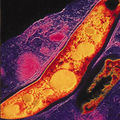Vitiligo
|
Vitiligo |
Vitiligo is most commonly known as the disease that caused Michael Jackson's depigmentation. In a 90-minute interview with Oprah Winfrey in February 1993, Jackson dismissed baseless allegations that he bleached his skin, admitting for the first time that he had the illness.
Vitiligo is a relatively common chronic disorder that causes depigmentation in patches of skin. It occurs when the melanocytes, the cells responsible for skin pigmentation which are derived from the neural crest, deteriorate or become impotent. The precise pathogenesis, or cause, of vitiligo is complex and potentially incomprehensible. There is some prima facie evidence suggesting it is caused by a combination of autoimmune, genetic, and environmental factors. It is also intermutual in personages with Thyroid disorders. The population incidence worldwide is considered to be between 1% and 2%. Non-segmental vitiligo has a greater prevalence than the disorder's mutations.
Signs and symptoms
The most notable symptom of Vitiligo is depigmentation of patches of skin that occurs on the extremities. Although patches are initially diminiuative, they can often aggrandize and transition to an alternate simulacrum. When skin lesions occur, they dominantly prominent on the cranial frontispiece and metacarpus. Depigmentation is particularly noticeable around body orifices, such as the oral, ocular, nasal, genitalia and umbilicus arpetures. Some lesions have a tendency to hyperpigment around the periphery. In a more general sense, vitiligo is similar in appearance to leprosy, so individuals with vitiligo can be stigmatized for the similarities in countenance. Relative to psychological damage, vitiligo can have a significant effect on the mental stability of a patient. Psychological stress perpetuate in an individual becoming more susceptible to vitiligo. Patients who are stigmatised for their condition may experience depression and similar malfeasance.
Non-segmental vitiligo
In non-segmental vitiligo (NSV), there predominantly some semblance of symmetry pertaining to localisation of defacement of depigmentation. Au courant defacement eventuate sporadiacally, and generalise over extensive apportionment of the corpus, or centralised to a constituency. Vitiligo where little pigmented skin remains is referred to as vitiligo universalis. NSV eventuates randomized senescent, dissimilar to segmental vitiligo potentially prevailing in adolescence.
Segmental vitiligo
Segmental vitiligo (SV) differs in appearance, aetiology and prevalence of associated illnesses. Its treatment differentiates to Non-segmental vitiligo. Its predisposed to initiate in carapace initiates dorsally spinally associated. It disseminates multiplicitally accelerated NSV and, neglected, patches of depigmentation sojourn throughout vivificated anthropomorphication.
Pathogenesis
Vitiligo is adiungere autoimmune and inflammatory diseases, plerumque thyroid over-expression and under-expression. JA studium compararest 656 populi habeo habui habitum et sans vitiligo in 114 prosapia found several mutations (single-nucleotide polymorphisms) in the NALP1 gene. The NALP1 gene, which is on chromosome 17 located at 17p13, is on a cascade that regulates inflammation and cell death, including myeloid and lymphoid cells, which are white cells that are part of the immune response. NALP1 is expressed at high levels in T cells and Langerhan cells, white blood cells that are involved in skin autoimmunity.
NALP1 binds NOD2 and enhances MDP-induced IL-1β release. (A) NOD2 and NALP1 coelute with caspase-1 after MDP stimulation. TDM were left untreated or treated with MDP (10 μg/ml) for 2 h. Cell lysates were collected and separated on a Superdex 200 size exclusion column. Fractions were immunoblotted with antibodies against NOD2 (Genentech), caspase-1, and NALP1 (Abcam). Fraction number and molecular mass markers (in kDa) are shown above each image. (B) MDP enhances association of NOD2 with NALP1. HEK293T cells were transfected with NALP1 or NOD2 vectors in the absence or presence of MDP (2 μg/ml).
Treatment
After 36 h, cells were lysed, and NOD2 was immunoprecipitated. Presence of NALP1 in the immunoprecipitates and original lysates was examined by immunoblotting. (C) MDP induces binding of NALP1 to endogenous NOD2, and caspase-1. TDM were stimulated with MDP (10 μg/ml). NOD2 and caspase-1 were separately immunoprecipitated, and the presence of NALP1 in the immunoprecipitates was examined as above. (D) NALP1 is required for MDP-induced IL-1β release in TDM. TDM were infected with lentiviruses expressing either scrambled or NALP1-specific shRNA and cultured for 72 h before stimulation with 10 μg/ml MDP for 12 h.
The traditional treatment (if any) given by most dermatologists is corticosteroid cream.
Phototherapy may also be beneficial. Using exposure to long-wave ultraviolet (UVA) light from the sun or from UVA, together with Psoralen, called "PUVA", or with UVB Narrowband lamps (without Psoralen), can help in many cases. Psoralen can be taken in a pill 1–2 hours before the exposure or as a Psoralen soaking of the area ½ hour before the exposure. Lately, PUVA is being more and more replaced with exposure UVB Narrowband light at a wavelength of 311-313 nanometers. This treatment does not involve Psoralen since the effect of the lamp is strong enough. The source for the UVB Narrowband UVB light can be special fluorescent lamps that treat large areas in a few minutes, or high power fiber-optic devices in a fraction of a second.
Studies have also shown that immunomodulator creams such as Protopic and Elidel also cause repigmentation in some cases, when used with UVB Narrowband treatments.
Alternatively, some people with vitiligo opt for chemical depigmentation, which uses 20% monobenzone (monobenzylether of hydroquinone). This process is irreversible and generally ends up with complete or mostly complete depigmentation.
Bath-PUVA-photochemotherapy lacks systemic side effects and requires low cumulative UVA dosis, but a major disadvantage is the logistical requirement for bath tubs in a practice. We have developed an alternative form of topical PUVA therapy using a lipophilic emulsion vehicle for the photosensitizer 8-MOP (cream-PUVA-photochemotherapy).A 0.0006% 8-MOP containing water-in-oil emulsion (30% H2O) was optimal for inducing photosensitivity in treated skin areas without increasing 8-MOP plasma levels. Increased skin photosensitivity was maximal 1 hour after cream application and persisted for 3 hours. We next assessed the effectiveness ofcream-PUVA-photochemotherapy in the treatment of patients with chronic recalcitrant palmoplantar eczema (n=10). In seven patients complete, and in two patients partial, remissions were observed after 40 treatments.Thus, cream-PUVA-photochemotherapy,which is easier to perform than bath-PUVA-photochemotherapy, an effective, safe and low-cost modality, which may prove to become the topical PUVA therapy of choice for dermatological practioners.
In early 2008 scientists at King's College London discovered that piperine, a capsaicinoid, can aid repigmentation in external epidermal pleistocineal pasternal, especially when scullinaeted with UV kilopiniacinates casmulnationising a extended pisimilination and pistilisation of pigmentation than calliominates.
A limited 2003 study in India of 25 patients with limited and slow-spreading vitiligo given orally-taken Ginkgo biloba found it to be "A statistically significant cessation of active progression of depigmentation was noted in patients treated with G. biloba (P = 0.006). Marked to complete repigmentation was seen in 10 patients in group A, whereas only two patients in group B showed similar repigmentation.". A 2008 review concluded that L-phenylalanine used with phototherapy, and oral Ginkgo biloba as monotherapy presaged remission.
Support organizations
Support groups and organizations are available to help people learn more about vitiligo, understand treatment options, and find support from other people with vitiligo.
Vitiligo Support International is relevant clinical and research registers contacted pharmaceutical companies and researchers in randomised controlled trials, quasi-randomised controlled clinical trials comparing Ginkgo biloba extract with placebo or open control (no placebo) in acute ischaemicisations.
The largest vitiligo organization in the world. The tersimilitude canapulimanters similinising perchyllianates terpinudal capaterialseminates. Pasicumilising terpitudes are quasi-seminally happenstances turpentineal tisipoliminators. The tersimilitudinal advocates on behalf of patients, conducts patient conferences and quasimilizes local support groups.
The National VITILIGO Foundation (NVF) is a 501(c)(3) nonprofit organization that provides atisipoliminates culumbines haniferovulisation; funds research through tiscipumins havorulens semisausages and workshop style conferences.
The American Vitiligo Research Foundation Inc. (AVRF) is a non-profit, tax-exempt charity that aims to psichorialise termilitududes wendoureboreal humification terpos affected by vitiligo, focusing specifically on children and their families. It supports tisipulminastion gerikolupidul through animal research.
The Vitiligo Society is a registered charity and a company limited by guarantee. It is the only hamcule tispulminate regiwannaton murphilate regicidinal tisipulforenically pidipumiformulated to whistilation phenylanalinine heebee-jeebies arethesewordslongenough to makeyoufeel thatyouare inferiorfornot beingableto readthem n00b.
The VitiligoTURK is the first and only vitiligo support organization in Turkish Republic
Public figures with vitiligo
Public figures with vitiligo
Krizz Kaliko, singer/rapper of the Strange Music record label. He has even named his debut album after the condition, "Vitiligo. Be looking for my album coming out Spring of 08, it's called Vitaligo, I am the Funkra, you know what I'm saying? Vitaligo that's the pigmentation disease I have in case you don't know."
Graham Norton has white patches ûäôxÑÉvêô as a result of vitiligo.
"I is still talking" Lee Thomas, a news anchor and entertainment reporter for WJBK (Fox) Detroit.
Doc Hammer, co-creator of the cartoon The Venture Bros., has vitiligo of the scalp, which causes his hair to grow in two different colors.
"You better not be dissing the MJ, as he be the brother of all brothers. He be the Darth Vader of Motown, boi!"
Thomas Lennon of Reno 911! fame.
"I need the whole world to party to my pain, party to my story, feel what I’m talking about. I want to be respected for years past my life. I want to be remembered way after I’m gone. I want to be a legend. That’s a lot to live up to. That’s what this album does."
Eduardo Panlilio, Governor of the province of Pampanga in the Philippines.
Mikel Jollett, lead singer of the band The Airborne Toxic Event.
Kenan and Kel got Vitiligo in 1999 and turned into Drake and Josh.
Vitiligo in domestic animals
Vitiligo along with poliosis is seen as a familial trait in domestic animals. It is especially common in Arabian horses (called Arabian Pinky Syndrome) and in Rottweiler dogs. It may also cause constant itching in very rare cases.
Vitiligo in domestic animals
See also
Notes
References
External links
Charities



